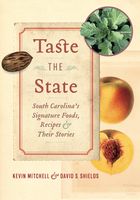Advertisement
Fritters
Appears in
By Kevin Mitchell and David S. Shields
Published 2021
Southern-fried . . . that’s what a fritter is. Whether in boiling lard, in bubbling Crisco, in peanut oil, or even canola, the fritter transforms from a heaping spoonful of batter into a crispy golden handful of savory or sweet sumptuousness. It has myriad faces: the beignet, the hush puppy, the oyster fried in cracker meal. They are eaten hot, or at least warm. And since they are finger food, the finger tips will feel a lick of heat.
The fritter family is large, organized by the grains used for the flour or meal, and also by the main ingredient. In South Carolina, you had fritters made from rice flour, from cornmeal, and from wheat flour. You had salty or sugary fritters. Fruit fritters tended to sweet (orange, banana, and pineapple had particular favor) and vegetable fritters to savory (salsify, peanut, green corn, potato). Seafood and fish fritters also tended to savory. Grain fritters included: cornmeal fritters (hush puppies/red horse bread); rice fritters (rice flour puffs or boiled rice fritters); and wheat fritters (beignets, doughnut holes, etc.), and could be either sweet or savory depending on the whim of the preparer of the tastes of the audience.

